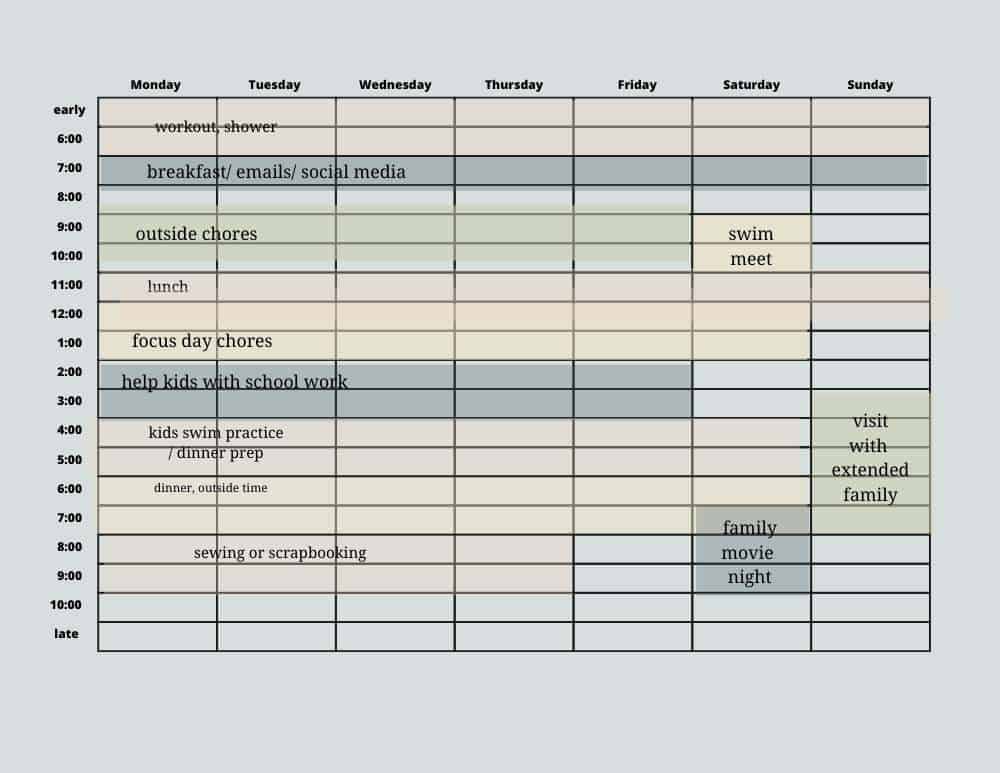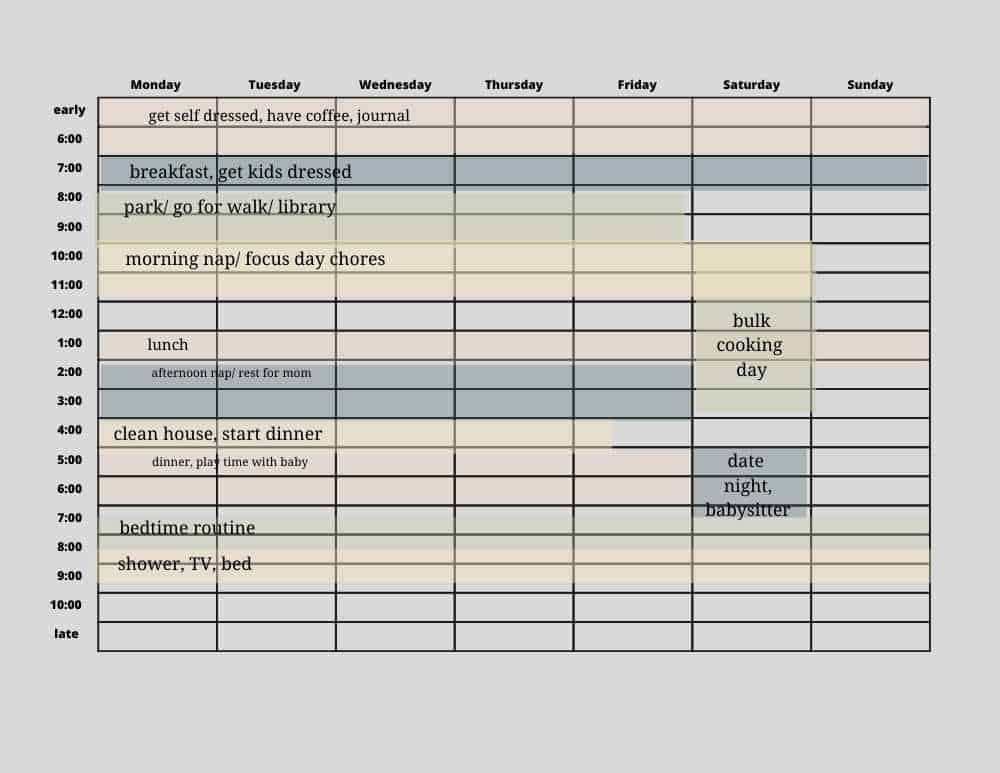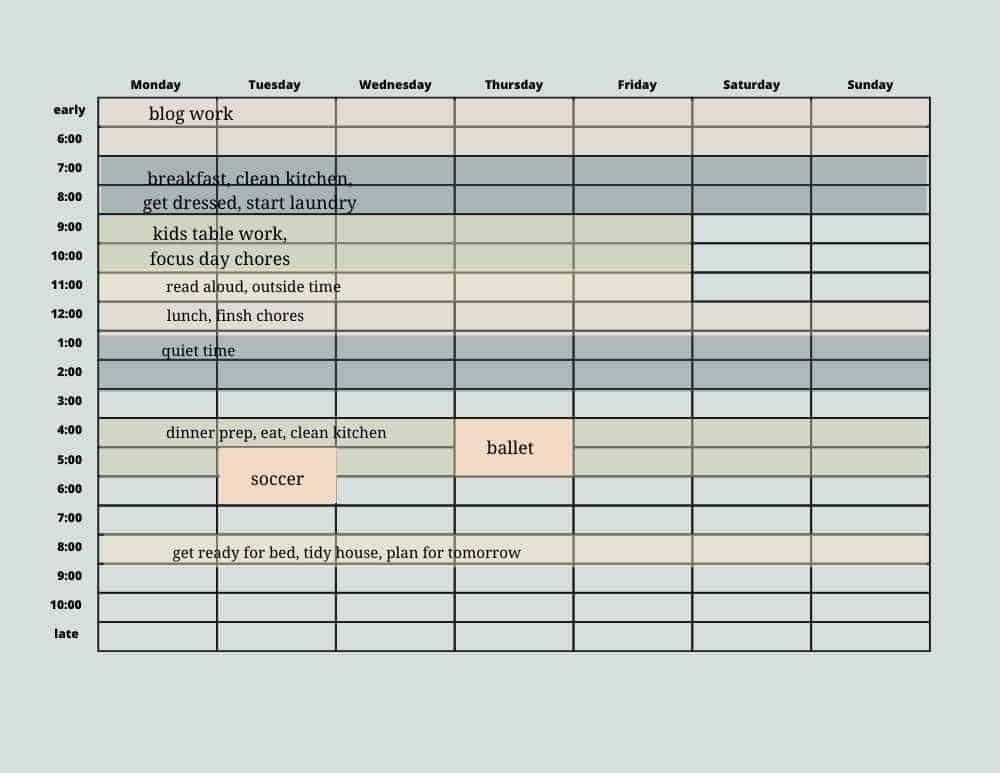Time Blocking for Homemakers
Inside: how to harness the power of time blocking for homemakers for a day that runs smoothly. When you go to bed, you’ll be amazed by what you’ve accomplished, instead of wondering where the day went.
Time blocking is simply the idea of dividing your day into blocks of…you know…time. Rather than having a simple list of things to do, you have a schedule that tells you when to do things. If it sounds crazy and limiting, it’s actually not. Having a schedule, with actual times, frees you from that nagging feeling of wondering what you’re supposed to be doing.

What are the benefits for homemakers?
- It gives you structure. and “false deadlines”. These force you to accomplish more.
- You will feel productive and no longer have that feeling that you’ve wasted your day
- You can put small tasks in their place so that you don’t waste all day on little things that don’t move you forward.
- The amount of time you actually have in your day will become very clear, which helps you understand what you can actually get done. (It may be more than you think, or less than you think!)
- If you can consolidate similar tasks into blocks of time, you won’t spend so much time switching tasks.
Why switching tasks loses productivity
Think of your brain like a computer. (An old, slow one with a few viruses.) Let’s say you need to edit 20 photos, play solitaire for 20 minutes, and send 10 emails. Would it make sense to log into your email account, send 1 email, then open a game and play for 5 minutes, then open your photo editor and edit 2 photos? And then repeat the process until everything was done?
heirloom homemaker email course
A 5-day series straight to your inbox to help you create a beautiful home life.
No logins, no guilt, no overwhelm.
Promise.
I promise to keep your email address safe. Unsubscribe at any time
Nope.
And similarly, it doesn’t make sense to run around all day, reacting to little things and not really getting anything done. Starting a load of laundry, then forgetting about it, then checking email for five minutes, then wondering what’s for dinner, then rummaging in the freezer, then looking online for a recipe, then…. you get the idea.
You waste tons of time by switching your brain, or computer, from task to task. And even worse, you never get “in the zone” of peak productivity. You never get to harness the power of “deep work”.
Deep work vs shallow work
For work productivity
Shallow work is easy to figure out. For people who work outside the home, shallow work is things that are technically work but don’t really get anything accomplished: checking emails, sitting in meetings they don’t really have to be in, arranging their desks.
In contrast, deep work is when your brain is fully engaged and you are doing things that you can’t do while you are distracted. A work project that requires focus and actually moves the needle would be deep work.
For home productivity
When you stay at home, you have a lot of shallow work to do. That’s just the way it is. There are diapers to change, counters to wipe, and little messes to clean up. All of that gets undone by the end of the day. It’s still important, but it is frustrating to spend all day on things like that.
If you feel overwhelmed by shallow work, there are a few things you can try:
- Delegate! Even small children can and should clean up after themselves as best they can and help you with small tasks. Something simple like an inexpensive grocery delivery service can help free up big blocks of time.
- Save shallow work for when you are occupied with other things. Clean the kid’s bathroom while you are watching them in the tub, respond to emails while you’re at their soccer practice, sweep the kitchen while you wait for water to boil.
- Block out times for shallow work! Time blocking is a huge help with this. You will carve out specific times for deep work, and don’t let anything get in the way of it.
Deep work… for homemakers?
Yes, there is deep work for the stay at home parent! But you will need to seek it out intentionally. It may be in the form of a productive hobby like sewing or gardening. But regular housekeeping can also be a form of deep work. Anything that does not get undone by the end of the day counts as deep work, whether its cleaning out your fridge, organizing a bookshelf, or composing a symphony.
Anything that you think will require deep work will need to scheduled as you work on time blocking your day. If you have little ones, that means early morning, at night, or during nap time/ quiet time.
How to realistically implement this
- Write down everything you have to do at a fixed time (take the kids to school, after school activities, appointments, etc.)
- Write down all the other things you have to do that have more flexible times (cleaning, laundry, personal goals, etc.)
- Sketch out a grid 7 spaces long and 16 spaces tall, for seven days of the week and 16 waking hours, or use a simple spreadsheet on your computer.
- Write down your fixed obligations for the week in the time slots in your grid.
- Look at your other obligations: household work, a home business, homeschooling, and anything else. Can you block these together so that you get a lot done in a few hours? If the idea of “batching work” like this feels impossible, think about “doubling work”. Do two of one thing, like make two meals and freeze one.
- Write down your schedule and adjust as needed.
Tips for time blocking success
Before you start penciling in the things you want to get done, stop and think. Is the time available to you in each day enough time to get things done and still have time to sleep and relax? There is nothing wrong with finding that you have too much to do and need to take a step back. Get rid of things that you don’t have time for by either delegating them to someone else, or eliminating them.
Another common issue is that you are taking way too long to get basic things done. Your shallow work is taking over your life. Maybe you really need three hours in the morning to get yourself and your kids ready. But maybe you don’t. Try to shrink down things like this when you are looking for more time in your day. Often, tasks will expand to fill any time they can possibly take. Give them less time. You’re the boss.
Don’t be overambitious about blocking tasks together. You can’t do ten loads of laundry in two hours. There’s no need to write down impossible things and then feel bad when they don’t get done.
Schedule time to rest. It is good and necessary. You may find that enjoy a break much, much more when it becomes a scheduled break, rather than an extended feeling of doing nothing.
Leave some blank space! Things will pop up and life needs room.
Examples for stay at home moms
- Spend two or three hours in the kitchen doing bulk meal prep and stocking the freezer and preparing ahead for the week by chopping veggies, making bread dough, etc.
- Do all your weekly errands in one longer outing.
- Spend an hour a week planning your meals and your grocery list, rather than wasting mental energy on this day after day.
- Visit this post for more ideas about developing “focus days” to care for your home.
Sample time blocking for homemakers schedules
Example #1
Here is a sample time blocked schedule for a stay at home mom with older kids. They are involved in after school activities every afternoon but they are home during the day for distance learning.
She loves to craft so she has blocked time out for that in the evenings.

Example #2
This is the time blocked schedule of a young mom with little kids. Her day is largely driven by the needs of her kids. She bulk cooks on Saturdays while her husband is home because her days are so tiring that dinner is a challenge in the evenings.
She doesn’t have a lot of time for deep work but she makes sure to prioritize getting out of the house in the mornings and getting a rest in the afternoons.

Example # 3
Here is my schedule. I have three young kids so I have to block out time in the early morning and during their quiet time for me to do any deep work. I try to keep my weekends relatively un-blocked so they are flexible.

Go forth and time block!
Like most things, getting your schedule right will take a few tries. Use the examples as a jumping off point if you need to, but remember that everyone’s schedule will be very different.
I hope this helps you!
Love,











I love you post. Great ideas! Gonna test block time management!
I’ll post later if outcome! THANK YOU FOR INSIRATION!
hey Ann! good luck 🙂
This blog is by far the most I related to. Shallow work has indeed taken over my life. thank you for this!
Hi Raquel, thank you so much! It really is eye-opening when you realize how much shallow work takes over, isn’t it? I’m so glad this post resonated with you. Let me know how time blocking works for you!:)
Hi, I have clicked on links on your page and entered my email and haven’t received them. I am interested in the time blocking worksheet and the free homemaking workbook. Please advise. Thanks!
hey laura! I’m going to send them over manually using the email you gave me here. 🙂
I started doing this a couple weeks ago, and you’re right that it alleviates that feeling that your day has been wasted. But the hardest part has been sticking to my schedule daily. It doesn’t help if I create the schedule and then forget to look at it haha
haha tell me about it! I eventually had to tape my schedule to my fridge!
Great post! I’m an overall terrible manager of time, but I can see that I kind of naturally function this way. I didn’t really know what time blocking was! Thank you tor enlightening me!